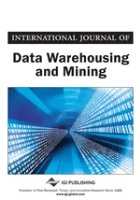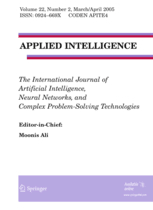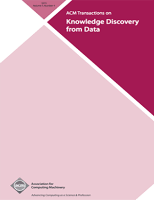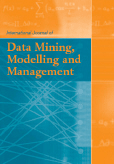
DATA MINING AND KNOWLEDGE DISCOVERY
Scope & Guideline
Connecting Theory with Practice in Data-Driven Solutions
Introduction
Aims and Scopes
- Data Mining Techniques:
The journal publishes research on various data mining techniques, including classification, clustering, regression, and anomaly detection, emphasizing novel algorithms and their performance in real-world applications. - Knowledge Discovery in Databases:
Contributions that explore the entire process of knowledge discovery, from data preprocessing and transformation to data analysis and interpretation, are a central theme. - Explainable AI and Interpretability:
A significant focus is placed on developing methods for explainable AI, enhancing the interpretability of complex models, and providing insights into decision-making processes in machine learning. - Time Series Analysis:
Research on methodologies for analyzing time series data, including classification, forecasting, and anomaly detection, is frequently highlighted, reflecting the importance of temporal data in various domains. - Graph and Network Analysis:
The journal covers advancements in graph mining and network analysis, focusing on algorithms for community detection, link prediction, and structural analysis of networks. - Fairness and Ethics in AI:
There is a growing emphasis on the ethical implications of data mining and machine learning, including fairness, bias mitigation, and the social impact of algorithms. - Data Stream Mining:
The journal actively publishes research on algorithms and frameworks for real-time data stream mining, addressing the challenges posed by continuous and high-velocity data. - Multimodal and Heterogeneous Data Integration:
Research that integrates diverse data types (e.g., text, images, and structured data) and develops methods for knowledge extraction from heterogeneous datasets is also a key area.
Trending and Emerging
- Explainable AI and Interpretability:
The increasing complexity of models has led to a surge in research focused on making AI systems more interpretable, with a strong emphasis on developing techniques that allow users to understand model predictions. - Deep Learning Approaches:
Deep learning continues to dominate the landscape, with an increasing number of publications exploring its application in various domains, particularly in time series analysis and image processing. - Fairness and Bias Mitigation:
Research focused on ensuring fairness in machine learning models and mitigating bias has gained traction, reflecting a broader societal concern about the ethical implications of AI. - Automated Machine Learning (AutoML):
The trend towards automating the machine learning pipeline is becoming more prominent, with studies on AutoML frameworks that simplify model selection and hyperparameter tuning. - Graph Neural Networks (GNNs):
The rise of graph neural networks has sparked significant interest, with publications exploring their applications in social networks, recommendation systems, and knowledge graph embeddings. - Real-Time Data Processing and Streaming Analytics:
As data generation accelerates, there is a growing focus on real-time data processing techniques and algorithms for mining data streams, reflecting the need for immediate insights. - Multimodal Learning:
Research integrating multiple data modalities (e.g., text, images, and structured data) is on the rise, driven by the need to leverage diverse information sources for improved knowledge extraction.
Declining or Waning
- Traditional Statistical Methods:
There is a noticeable shift away from purely statistical methods for data analysis towards more complex machine learning techniques, reducing the publication of traditional statistical approaches. - Basic Machine Learning Models:
As the field advances, there is less emphasis on basic machine learning models (e.g., simple regression or basic classifiers) as researchers focus on more sophisticated and hybrid models. - Domain-Specific Applications:
Research that is highly focused on narrow, domain-specific applications is declining, as there is a broader interest in generalizable methodologies that can be applied across various fields. - Manual Feature Engineering:
The trend is moving towards automated feature extraction and representation learning, leading to a decrease in publications centered around manual feature engineering techniques. - Single-Method Studies:
There is a reduction in the publication of studies that evaluate only one method in isolation, with a growing preference for comparative studies and ensemble approaches.
Similar Journals

KNOWLEDGE AND INFORMATION SYSTEMS
Empowering Innovation through Knowledge and ResearchKNOWLEDGE AND INFORMATION SYSTEMS, published by SPRINGER LONDON LTD, is a distinguished journal in the field of information systems, artificial intelligence, and human-computer interaction. With its ISSN 0219-1377 and E-ISSN 0219-3116, this journal has built a robust reputation since its inception, featuring a convergence of valuable research from 2005 through 2024. Catering to a diverse academic audience, it is classified among the leading journals in its category, proudly holding a Q1 ranking in Information Systems and Q2 rankings in multiple other domains. The journal aims to publish cutting-edge research that not only advances theoretical understanding but also provides practical applications within these rapidly evolving fields. Although it is not an Open Access journal, subscribers can access a wealth of knowledge critical for researchers, practitioners, and students looking to enhance their expertise. With a 2023 Scopus rank placing it within the 66th percentile for Information Systems, KNOWLEDGE AND INFORMATION SYSTEMS is an invaluable resource for those committed to pushing the frontiers of knowledge in technology and information science.

Foundations of Data Science
Elevating Data Science with Rigorous ResearchFoundations of Data Science, published by the American Institute of Mathematical Sciences (AIMS), is a pioneering journal dedicated to advancing knowledge within the ever-evolving fields of data science, mathematics, and computational theory. With an impact factor reflecting its quality and relevance, this journal has established itself as a crucial resource for researchers and professionals alike, achieving remarkable rankings in the Scopus metrics across various mathematical categories, including 35th in Analysis and 70th in Statistics and Probability. The journal, which has been continuously growing in significance since its inception in 2019, focuses on both foundational theories and applied methodologies, providing open access to cutting-edge research from 2024 onward. Its commitment to fostering interdisciplinary collaboration ensures that it remains at the forefront of the data science realm, making it an essential platform for students, scholars, and practitioners aiming to deepen their understanding and contribute to the scientific community.

International Journal of Data Warehousing and Mining
Navigating the Depths of Data AnalyticsInternational Journal of Data Warehousing and Mining, published by IGI Global, is a vital resource in the field of data management and analytics, catering to researchers, professionals, and students alike. With ISSN 1548-3924 and E-ISSN 1548-3932, this journal has been at the forefront of disseminating pioneering research since its inception in 2005 and will continue to do so through 2024. Despite its current categorization in the Q4 quartile for Hardware and Architecture as well as Software, and its Scopus rankings, the journal aims to foster innovation within the domains of data warehousing, data mining, and their applications across various sectors. The absence of an open access option does not diminish its significance; rather, it ensures that the journal maintains rigorous peer-review standards, providing high-quality research outputs that contribute to ongoing discussions and advancements within the field. Researchers and practitioners looking to stay updated on the latest trends and methodologies will find the International Journal of Data Warehousing and Mining an indispensable tool in their academic and professional endeavors.

APPLIED INTELLIGENCE
Advancing the frontiers of Artificial Intelligence applications.Applied Intelligence is a prominent peer-reviewed journal that has been instrumental in advancing the field of Artificial Intelligence since its inception in 1991. Published by Springer, a reputable name in academic publishing, the journal focuses on the innovative applications of intelligent systems, algorithms, and methodologies across various disciplines. With an impressive Q2 ranking in the Artificial Intelligence category for 2023, and a Scopus rank of #117 out of 350 in its field, Applied Intelligence is recognized for its significant contributions and rigorous standards. The journal is accessed primarily through subscription, ensuring that high-quality research reaches the academic community and industry professionals alike. Its commitment to disseminating cutting-edge research makes it an invaluable resource for researchers, practitioners, and students interested in the practical implications of AI advancements. Join a community dedicated to exploring the transformative power of artificial intelligence and stay ahead in this ever-evolving field!

ACM Transactions on Knowledge Discovery from Data
Pioneering Discoveries in Data Mining and AnalysisACM Transactions on Knowledge Discovery from Data (TKDD), published by the Association for Computing Machinery, is a prestigious journal at the forefront of the interdisciplinary realm of data mining and knowledge discovery. With an impressive Q1 ranking in Computer Science and a Scopus rank of #43 out of 232, this journal stands out as a top-tier resource for innovative research that addresses complex challenges in data science. Covering impactful studies from 2007 to 2024, TKDD presents cutting-edge algorithms, methodologies, and applications that shape the future of knowledge extraction from vast datasets. While not an open-access journal, it provides a platform for researchers, professionals, and students to disseminate their findings and engage with the latest advancements in this rapidly evolving field. By fostering collaboration and knowledge sharing, TKDD plays a vital role in advancing the understanding and application of data analysis techniques, making it an essential read for anyone involved in the pursuit of knowledge from data.

International Arab Journal of Information Technology
Connecting Scholars to Transform the Tech WorldWelcome to the International Arab Journal of Information Technology, a prestigious publication under the aegis of ZARKA PRIVATE UNIVERSITY in Jordan, dedicated to advancing the field of Information Technology. First established in 2008, this journal has made significant strides in disseminating high-quality research, achieving an impressive Q2 ranking in Computer Science (miscellaneous) and securing a notable 57th percentile position in the Scopus rankings. With a comprehensive scope encompassing various sub-disciplines of computer science, the journal is committed to promoting scholarly dialogue and innovation among researchers, professionals, and students. While currently operating as a subscription-only journal, it remains a vital resource for the academic community seeking to explore the latest trends and advancements in technology. The International Arab Journal of Information Technology is not only a platform for original research but also a vibrant hub for ideas that shape the technological landscape of the Arab region and beyond.

International Journal of Data Mining Modelling and Management
Empowering Researchers with Cutting-Edge Data InsightsInternational Journal of Data Mining Modelling and Management, published by InderScience Enterprises Ltd, is a prominent academic platform dedicated to the exploration and advancement of data mining techniques and their applications across various domains. Located in the picturesque environment of Geneva, Switzerland, this journal serves as a crucial resource for researchers, professionals, and students engaged in the fields of Computer Science, Management Information Systems, and Modeling and Simulation. With an ISSN of 1759-1163 and an E-ISSN of 1759-1171, the journal has steadily converged its scope from 2008 to 2024, emphasizing innovative methodologies and dynamic developments in data analytics. Although currently categorized in Q4 for several relevant fields according to 2023 quartiles, the journal is committed to elevating its impact and outreach through rigorous peer-reviewed research, making it an essential read for those aiming to stay at the forefront of data-driven decision-making and management practices. Whether you are a seasoned researcher or an eager student, the International Journal of Data Mining Modelling and Management offers invaluable insights and contributions to the evolving conversation in data science.

JOURNAL OF INTELLIGENT INFORMATION SYSTEMS
Catalyzing Knowledge in Intelligent Information TechnologiesThe Journal of Intelligent Information Systems, published by Springer since 1992, is a premier academic journal that offers a multidisciplinary platform in the fields of Artificial Intelligence, Computer Networks and Communications, Hardware and Architecture, Information Systems, and Software. With an impressive impact reflected in its 2023 Q2 category rankings across multiple domains and a commendable standing in the Scopus Rankings—ranking #84 in Computer Networks and Communications and #101 in Artificial Intelligence—the journal is recognized for its contribution to advancing knowledge and innovation. Although it is not an open-access journal, its accessibility through institutional subscriptions ensures that a wide range of researchers, professionals, and students can engage with high-quality, peer-reviewed research that addresses the latest advancements and trends in intelligent systems. For over three decades, this journal has effectively bridged gaps between academia and industry, making it a vital resource for those aiming to push boundaries in intelligent information systems.

Frontiers in Big Data
Bridging Theory and Practice in Big Data TechnologiesFrontiers in Big Data, published by Frontiers Media SA in Switzerland, is a leading open access journal that has established itself as a vital resource for scholars and practitioners in the expanding realms of artificial intelligence, computer science, and information systems since its inception in 2018. With an impressive impact factor reflected in its Q2 rankings across multiple categories, including Artificial Intelligence, Computer Science (Miscellaneous), and Information Systems, this journal serves as a pivotal platform for disseminating groundbreaking research and promoting interdisciplinary collaboration. The journal's commitment to open access ensures that high-quality research is readily accessible to a global audience, fostering the exchange of innovative ideas and advancements in big data technologies. By creating an inclusive space for diverse perspectives, Frontiers in Big Data aims to bridge the gap between theoretical research and practical application, making it an essential read for anyone invested in the future of data science.

JOURNAL OF COMPUTER SCIENCE AND TECHNOLOGY
Exploring Innovations in Computational Theory and PracticeJOURNAL OF COMPUTER SCIENCE AND TECHNOLOGY, published by Springer Singapore Pte Ltd, is a pivotal platform in the rapidly evolving realms of computer science and technology. With an ISSN of 1000-9000 and an E-ISSN of 1860-4749, this journal encompasses a diverse array of topics including computational theory, hardware and architecture, software engineering, and applications of computer science. Spanning over three decades from 1986 to 2024, it boasts an impressive standing within academic circles, ranking in the Q2 quartile across several key categories and achieving notable placement in Scopus metrics. Although this journal operates under a subscription-based model, it remains a crucial resource for researchers, professionals, and students seeking to advance their knowledge and contribute to discussions in computer science. The JOURNAL OF COMPUTER SCIENCE AND TECHNOLOGY is committed to fostering innovation and scholarly communication in the field, encouraging submissions that contribute substantive advancements in theory and application.